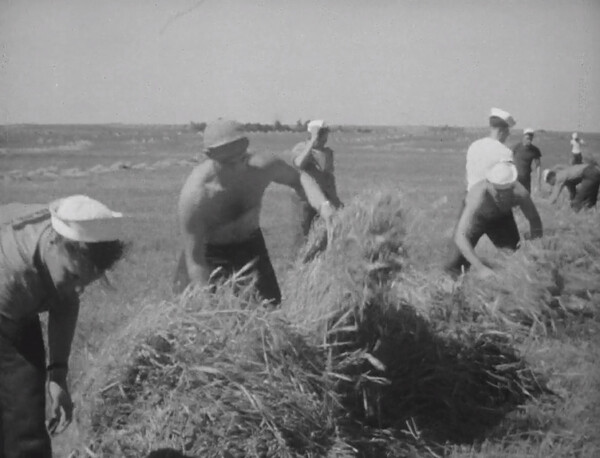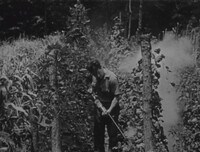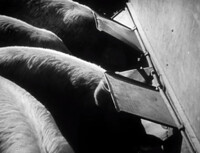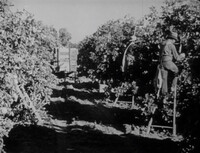Agriculture
Part of a speech by a local county extension agent encouraging school children to help harvest food.
The heightened need for food throughout the world demanded more than just victory gardening, but also the increased production of food within the agricultural industry itself. The focus on raising the output of the agricultural industry followed the similar situation as WWI. During that war, the drafting of men caused a labor shortage which had to be solved to meet the new wartime harvest targets. In addition to immigrant and temporary visa farm laborers, a large source of temporary agricultural labor came from women, who took seasonal jobs or volunteered as farm laborers.62 Given similar demands for increasing food products, farmers once again raced to secure labor and meet the food production goals during WWII.
With America’s entrance into WWII, U.S. farmers were tasked with producing more with less. For the 6 million farms and ranches in America at the time, the government encouraged increased production, going against many of their messages of lower yields to stabilize and increase prices to farmers over the preceding decade of the Great Depression.63 To vocalize the message, the USDA MPS created several films aimed directly at the agricultural community. These films encouraged scrap metal donation drives, conserving resources, the maintenance of farm equipment, and increasing yields combined with an overall patriotic theme. Like victory garden motion pictures, MPS farm films stressed the immediacy of the food shortage and the great importance of the agricultural industry in winning the war. A prime example of this is the narrator’s remarks six minutes into The Farmer’s Wife, “No Fancy uniforms, no flags, no bands are playing, but a good producing farm is worth more than any gun, more than any airplane or tank… .” Given rationing systems farmers were told to operate with extreme efficiency, “Let’s not waste a grain, not waste anything. Let’s do everything we can to help win this war. This total war that reaches everyone of us. Reaches every house. Every kitchen.”64 To fulfill the wishes of the USDA, the agricultural industry would come to rely on new sources of labor.
With the draft taking millions of men out of the labor force, American agriculture relied on new groups of laborers to complete harvests. In desperate need to harvest before crops would rot in fields, farmers turned to immigrant labor to replace laborers lost to the draft and the substantial Japanese-American population sent to internment camps that were regular farm hands previously.65 The major source for imported labor was Latin America, and included workers from Mexico and Jamaica.66 If farms were located near war camps, prisoners of war were also used as harvest hands. Prisoners of war were desirable farm help, as wartime prisoners in Kentucky could be paid $3.20 for an eight-hour work day compared to $7.50 for local labor.67 Still in desperate need for extra help, farmers turned to local extension offices and county agents for the Farm Labor Office to round up local help. Sometimes paid and other times as volunteers, women and local communities were organized into farm service.68 1943 appeared to be the most in-need year for extra agricultural labor, with over 600,000 non-farm women working on farms.69 Women could be seen harvesting crops and driving tractors, among other farming activities. Additional help came from children, who were encouraged by organizations, like 4-H, and MPS films to dedicate their time to farm work. Films advertised excused absences from school and pay during the harvest season to lure children in. The film Victory Harvest even referred to teenage school children as “soldiers of the soil” in recruiting efforts.70 The patriotic call for farm labor help was answered by a variety of groups.
The results from all these endeavors were immense. From 1940 to 1943, agricultural production within the U.S. raised 16 percent.71 Even with wartime restrictions on resources, farmers were aided by more tractors, jumping from about 1.5 million tractors in 1940 to 2.1 million tractors in use by 1943.72 Production targets were not limited to a few specific crops either, almost anything grown commercially in the U.S. had a wartime use. The challenge of what to grow was complicated due to a lack of communication between the military and the USDA, leading the USDA to have to guess about the military’s upcoming needs.73 Shortages and outpacing demand for inedible crops also grew. Tobacco consumption increased upward of 75 percent throughout WWII, and a shortage lasted from 1944 until victory in Europe was officially declared in 1945.74 Another unsuspecting crop to see greater focus in the war effort was hemp. Hemp production was encouraged in the U.S. as the crop could be used for making ropes critical for the operation of ships, which became a concern due to insecure supply lines for regular rope making materials.75 U.S. farms successfully adapted to the patriotic calls put forth by the USDA to feed the troops and the world during WWII.






